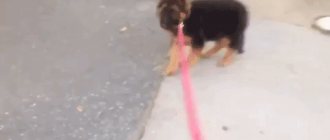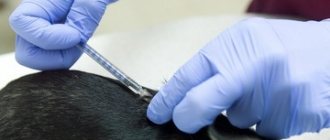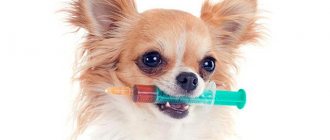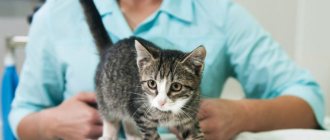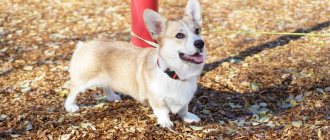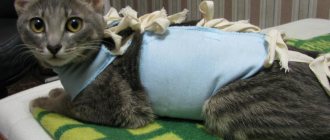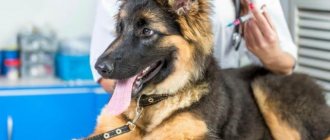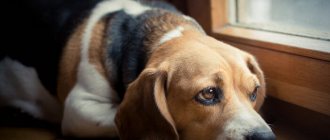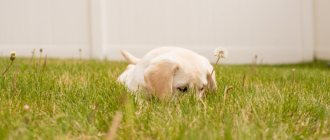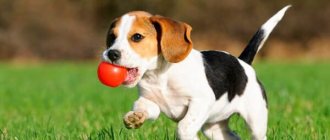- October 19, 2018
- Dogs and hunting with them
- Galina Chebykina
After what vaccination can you walk your puppy? This question interests all people who have a pet and are going to care for it and monitor its health as it should be. Today we offer to learn about what vaccinations an animal must have before it reaches one year of age, and what rules to follow before and after vaccination. You will find out how long you should not walk your dog after vaccination and why.
First vaccination
A respectable breeder will not take a puppy from its mother until the age of 4 weeks, since it is during this period that the baby develops passive immunity through the milk of an adult dog. In this age period, morbidity is very rare.
But is it possible to go for a walk, the puppy’s first vaccination has not been given, but he lives with his mother? The baby has immunity, but it is still weak; the puppy can easily become infected from other animals, from toys, human shoes, and so on. Before the first vaccination, your pet must not have contact with animals that are not vaccinated, and you cannot walk with it either!
At the age of 8 to 12 weeks, the baby becomes extremely susceptible to various types of diseases; it is during this period that the first vaccine is recommended. Next, you need to follow safety rules after vaccination. How long after can a puppy go for a walk? Immunity is developed over the course of 21 days, then re-vaccination is carried out, at the same time vaccination against rabies is carried out. Then the animal again develops immunity over the course of 21 days. Knowing this schedule, you can easily calculate when you can walk your puppy after vaccination.
When to walk your adult dog after vaccination?
Immunization for stronger adult animals is repeated annually, and the injection is given with complex preparations, including pathogens of several infections. It is permissible to add a separate injection to the indicated injection, which forms resistance to rabies. In females, the immunization schedule depends on estrus, mating, and begins a month before the indicated processes.
Walking adult dogs is not prohibited, but by the end of the 11th – 12th month, immunity decreases, so you should walk before and after vaccination for 14 days separately from other dogs, without intense physical activity. It is better to extend the quarantine period to 21 days to avoid contracting rabies. In cold weather, the dog does not need to be washed; just rinse its paws with warm water and treat the coat with dry shampoo.
Read. Associated vaccine for rabbits against Myxomatosis
After quarantine, the dog is gradually returned to active activities, allowed to swim in reservoirs, and restrictions on interactions with any animals are removed.
Vaccinations up to one year
We suggest that you familiarize yourself with the recommended vaccination schedule. Keep it for yourself, because knowing after what vaccination you can walk your puppy, you will be able to find out at what age you will start walking, and protect the animal from contracting dangerous diseases.
- Not always at 3-4 weeks, but the first PUPPY vaccination is given. The vaccine is required only in the most extreme cases: the mother is infected, there is an epidemic in the nursery, the risk of infection of the baby is high. Do not confuse this with the first mandatory vaccination, which will begin the 21-day countdown to the second, and then to the third—against rabies.
- At the age of 8-10 weeks, the dog is given the first vaccination, which develops immunity against distemper, enteritis, hepatitis, parainfluenza, and leptospirosis. As you understand, this is a mandatory vaccination for puppies. When can you go for a walk? It is not recommended to rush, it is better to wait for the third vaccination, and only after that take the baby outside. If there is no choice and the puppy needs to be placed with other animals or taken out into the yard, then do this no earlier than the 14th day after vaccination, since immunity only develops over the course of 2 weeks, and quarantine is necessary.
- 3 weeks after the first vaccination, that is, at the age of 11-13 weeks, the dog is given a second vaccination - a revaccination is carried out, which strengthens the immunity. This vaccination is also mandatory, but only for puppies; subsequent annual vaccinations are administered once. When can a puppy go for a walk after the second vaccination? It is advisable to postpone all walks for another 2-3 weeks and keep the baby in quarantine.
- The rabies vaccine is administered along with the second vaccination. It can be postponed until six months, if until this time the puppy will definitely not have contact with other animals. If you do not vaccinate immediately, then for the safety of both the animal and yours, postpone all walks and accustom your dog to only a diaper at home for now.
- At 6-7 months they give a third vaccination against distemper, enteritis and all other diseases prescribed above. Walking is not recommended for 2 weeks after vaccination.
- The fourth vaccination follows at one year of age. Again, you need to quarantine for 2 weeks.
Is contact with other puppies allowed?
During quarantine, communication with other puppies is not recommended. It's another matter if they are from the same litter and vaccinated at the same time.
Puppies
For the first and second vaccinations of a puppy, the quarantine period is at least 2 weeks. When immunized against rabies, this period is extended to 3 weeks.
The following rules must be followed:
- walk exclusively with a puppy in your arms;
- avoid walking areas of other dogs;
- no bathing;
- Avoid contact with street shoes and door mats.
Inactivated or attenuated vaccines: what is the difference, which one to choose?
Attenuated vaccine. In this case, a small amount of live, weakened viruses is injected into the animal. Once in the blood, viruses begin to multiply, causing the formation of immunity to fight them. The puppy suffers from the disease, but in a weak form, immunity is developed quickly, after a week it is persistent and lasts up to three years!
Inactivated vaccine. This is a larger amount of the injected virus, it does not multiply, immunity is developed more slowly and lasts only a few months.
After what vaccination can you take your puppy for walks before? Theoretically, after attenuated, because immunity is developed within a week. But veterinarians recommend that in both cases it is better to wait the recommended time, and schedule walking only after quarantine after the 2nd vaccine.
Is quarantine mandatory?
If your dog is not vaccinated or quarantined before and after vaccinations, it can become infected with one of the following diseases:
- plague;
- parainfluenza;
- enteritis;
- rabies;
- leptospirosis;
- infectious hepatitis.
Whether to get the first two and subsequent vaccinations or not is up to you, but in Russia it is mandatory to vaccinate animals against rabies! If you do not comply with the recommended quarantine and walk before vaccinations or immediately after them, then there is a high probability that the animal will get sick. Of course, today veterinary medicine has stepped very far forward, but even if the dog does not die, during the illness he will be severely exhausted, and irreparable harm will be caused to the body.
Etiology of diseases
All three infections are viral in nature and affect the respiratory system and immune system. In severe cases and complications, internal organs, vision, the reproductive system (with mumps) and the nervous system can be damaged.
- Measles is characterized by a combination of eye and respiratory tract lesions and skin rashes. First manifestations:
- small white spots on the cheeks and gums (Koplik's sign);
- redness of the eyes;
- snot, nasal congestion;
- dry strong cough;
- heat;
- a pinpoint red rash that appears from the top of the head to the heels. Source: I.L. Solovyova, E.A. Alexandrova, E.M. Lezhen, O.V. Anosova, A.A. Solovyeva Vaccinal prevention of measles and mumps in children in modern conditions // Ulyanovsk Journal of Medical Biology, 2013, No. 4, pp. 47-53
Without treatment, measles is dangerous for the development of purulent otitis, bronchitis and pneumonia, as well as the formation of encephalitis.
- Mumps is a lesion of glandular tissue and respiratory organs. Typical for him are:
- runny nose;
- temperature increase;
- severe malaise with headache;
- muscle aches;
- pain in the masticatory muscles when swallowing;
- inflammation of the salivary glands with swelling behind the ears and along the edge of the lower jaw;
- dry mouth, decreased appetite, severe thirst.
With complications of mumps, inflammation of the appendages (in girls) and testicles (in boys) may develop, followed by infertility, as well as deafness, and the development of meningitis.
- Rubella is milder and is characterized :
- moderate temperature;
- redness of the eyes;
- the appearance of a rash on the skin;
- enlarged lymph nodes in the back of the head and neck;
- joint damage.
Rubella is especially dangerous for children and can lead to bronchitis and otitis media. For pregnant women, there is a risk of fetal defects. In rare cases, children may have bronchitis, otitis media or pneumonia.
Imported or domestic vaccines?
After which vaccination can you take your puppy for walks first - after imported or domestic? There is absolutely no difference here! When choosing a vaccine from any manufacturer, you must prepare the dog (we’ll tell you how to do this later) and withstand quarantine.
Imported vaccines are more expensive than domestic ones, and many therefore believe that their quality is higher and choose them. But veterinarians insistently recommend that puppies be vaccinated against distemper only with a Russian-made vaccine, since after imported vaccinations there have been cases of infection with this disease, even though the owners vaccinated the dogs following all the rules.
In any case, the veterinarian will advise you on everything himself and tell you about the advantages and disadvantages of any vaccine produced.
Preparing the puppy for vaccination
Only a completely healthy animal should be vaccinated, and the veterinarian will definitely check this. If the puppy is already sick, then vaccination will not help, it will only worsen his condition. This is not a cure, it is the virus itself, only weakened.
To avoid the negative consequences of vaccination, follow these rules:
- A week before vaccination, start measuring the animal’s temperature every day and examining its mucous membranes.
- After vaccination, you cannot walk for at least two weeks! The first walks should be made only in a clean area, without other animals.
- Contact with other animals only 21 days after vaccination.
- If the vaccination is in the morning, then do not feed the animal in the evening; if in the evening, then the last meal is 4 hours before. Vaccination is easier to tolerate on an empty stomach. You can give him something to drink.
Even if all the rules are followed, the animal will feel worse after vaccination. The vaccination itself is stressful, and the virus will begin to awaken the immune system. You shouldn’t worry too much, but you need to give the puppy more attention and care during rehabilitation.
Possible reactions and complications
The doctor will tell you in detail how the vaccine is tolerated, what kind of reaction to the vaccine is acceptable and when you should worry. After the injection, redness at the injection site and mild cold-like conditions are possible; in the period from 5 to 12 days, mild rashes are possible after vaccination. This is not dangerous; such a child’s reaction to the KKP vaccination is due to the fact that the injected viruses are live, weakened, and they imitate the infectious process in the body, stimulating the production of protective antibodies.
Possible side reactions and effects include allergic reactions, fever in the first 6-12 days. It is extremely rare that there may be more serious consequences and complications (thrombocytopenia, post-vaccination encephalitis), but all of them are likely in cases where contraindications are not taken into account.
Deworming
Even those babies who feed only on mother’s milk and do not come into contact with other animals must be treated against parasites before vaccination. If this is not done, then the vaccine will be of no use.
Anti-helminth medications are used 2-3 weeks before the day scheduled for vaccination. Choose the drug carefully; it is better to choose one that is used once. If you choose the one that needs to be applied twice, then you will have to start preparing the puppy from the age of one month in order to have time to carry out the second cleaning before vaccination.
Contraindications for carrying out
Contraindications to vaccination are determined by the doctor. They can be temporary - these are acute diseases (ARVI, influenza, intestinal infections, fever of unknown origin), exacerbation of chronic pathology, allergic reactions. Vaccination may be delayed if the child has just returned from a trip to another country, has had contact with sick people, and infection is possible.
Constant contraindications include allergies to vaccine components, tumor processes, congenital or acquired immunodeficiencies, severe blood diseases. If there was a strong reaction to the first vaccination, subsequent doses are prohibited.
Rules for walking after vaccination
We figured out when you can walk your puppy after vaccination, now we’ll find out how to do it correctly. After the first vaccine, after 2 weeks you can take your pet outside for a short time, but only in your arms, you cannot let it down to the ground! The first full walk can be scheduled on the 11-14th day after the second vaccination. Observe the following rules:
- Choose a sunny day without wind.
- Find a quiet place where there is no trash, other animals or strangers.
- For the first time, a 20-minute walk is enough.
Before you take your puppy outside, make sure he is in good health. He should not have a fever, lethargy or drowsiness. If the baby is active, eats well and plays, then feel free to take him to get acquainted with the world around him!
Why does a puppy need walks?
During the walk, interpersonal connections between the dog and the owner are established. With proper organization of periods of activity and rest, the puppy receives the necessary physical activity, and its nervous system is formed.
Puppies
Important! Exercise should be a joy for the puppy. There is no point in forcing him to do something by force.
To prevent the dog from getting tired of walks, they need to be done more often, but shorter in time. After basic vaccinations, the frequency of walks should be at least 5 times a day.
Getting to know the outside world begins even before vaccination. True, it passes in the hands of the owner. Even this form brings positive results. Many owners neglect going out with their small pets. The main excuse is that there are a lot of infected animals on the street, although a lot of things get into your home with street shoes. In any case, the baby will come into contact with the brought infection. It might even get infected.
The difference between greenhouse dogs and actively walking dogs is that the latter gradually acquire immunity against any infection precisely on walks. Pets are deprived of this, so even a small dose of pest viruses can be dangerous for them. They get sick longer and more severely.
Walking a labrador puppy
The second point is that the pet dog does not learn social coexistence skills. Experience communicating with representatives of your class is acquired from 4 to 8 months. It is much easier for a puppy to learn to live in the city, not to be afraid of people, cars, noise, or other animals in an environment. The psyche of children is quite plastic.
A slightly older dog explores the world on walks. To prevent this process from getting out of control, the owner must plan walks wisely. If at first walking was carried out in quiet places, then gradually the pet should be introduced to busy areas.
Need to know ! It is important for your puppy to change routes regularly. The more knowledge he receives, the more adequately he will behave as an adult.
In order not to become an attachment to the leash, the pet must be given loads throughout the entire walk. Elements of training should be gradually introduced.
Walking is of no small importance in fulfilling the natural needs of the animal. This is especially important for large breeds. If dwarf representatives (Yorkie, Spitz, Chihuahua) can be allowed to walk in a diaper, large ones (Dachshund, Husky, German and East European shepherds, Labrador, etc.) should not be allowed to do this even at a tender age.
The dog needs to empty its intestines and bladder 3-4 times a day. They can tolerate it, but then problems arise with the genitourinary system. Long-term restraint leads to chronic diseases, for example, urolithiasis.
Swimming is very useful for the general development and strengthening of the dog’s physical condition. You can start doing this from the age of three months.
